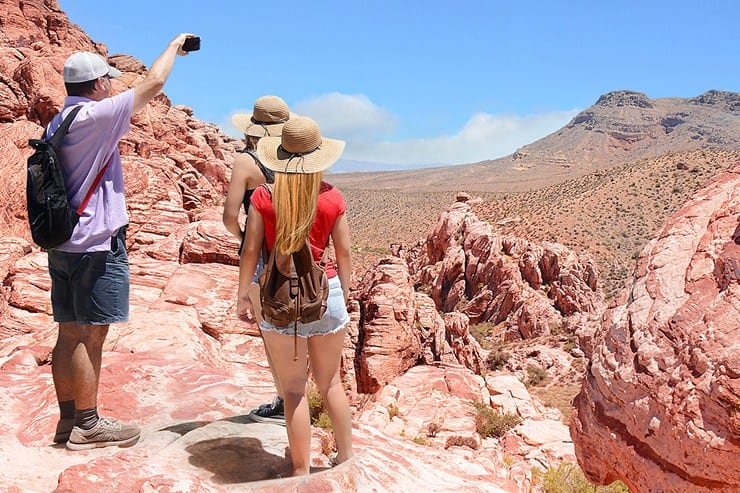Things would have been much simpler if I had known where I was going. But that wouldn’t have been nearly as much fun. As I hiked off into unknown terrain, I knew my geological field identification skills would be put to the test.
First I had to figure out where I was; only then I could figure out the geology. On my latest hiking “weekend winter getaway in Laughlin, Nevada” adventure, the location of each daily hike was nebulous. I had a suspicion of the type of rocks we might be hiking in, but since I didn’t know exactly where we would be going, I couldn’t do any research in advance. I had to fly (and slide down a few slopes) by the seat of my pants.

This past Sunday afternoon, our Utah caravan of cars continued south from Laughlin about eight miles on the road to Needles, CA. I knew we had crossed from Nevada into California when I passed a sign reading “San Bernardino County.” A quick right turn onto a gravel track took us a couple miles up into the foothills of a range later determined (thanks to a brand-new Delorme Atlas & Gazetteer of NV) to be the Dead Mountains.
There is much written concerning the tectonic history of this part of the southwest (click here for one interpretation and click on “free” for full text). Going in, I suspected the rocks in these mountains would contain igneous intrusions along with metamorphic schists and gneisses but I had no way of knowing any of the particulars. As I said, though, I did not even know where I was bound until I turned off the highway onto the gravel track.
Hikers are surely a funny bunch! They rarely want to stop and look at rocks but are most often determined to get as far on a trail or as high on a mountain as possible. Obsessive geology types like me, on the other hand, are content to stay on the same knoll for three hours, walking around with a camera and hand lens to check out whatever is there.
So as the others labored determinedly up the steep, trail-free slope to attain the peak of whatever unnamed mountain we were on, I stayed below to examine the outcrops of weathered schists, gneisses, amphibolites, igneous intrusions, and quartz veins that littered the hillside.
Unlike in the Beaver Dam Mountains of southwest Utah, I did not find any garnet or sillimanite in my cursory three-hour inspection of one knoll. Although absence of evidence does not signify evidence of absence, if there is indeed no sillimanite or garnet in these rocks (and I’m not say there absolutely isn’t – just that I didn’t find any), that would imply lower pressures and temperatures compared to the high-pressure rocks in the Beaver Dams to the north.
I did notice what I thought were possibly some shearing textures, though, but they didn’t jump out at me. By this time I was wishing I had some thin sections to look at under the petrographic microscope.
The only information I found (after an hour’s literature search on the internet, three days after the hike) was a map on the California Geological Survey website (also zoom in here to just southwest of Bullhead City, AZ). The ridgeline of the Dead Mountains is mapped as Precambrian rocks but nothing more specific. Woo Hoo! So far, I’m batting a thousand for field identification skills on the fly.






